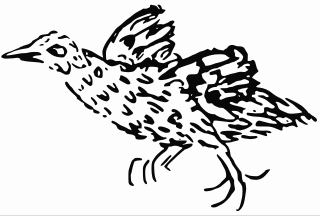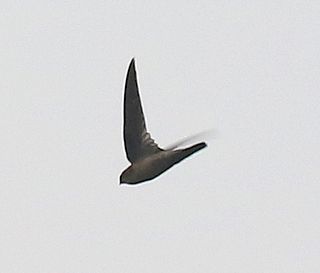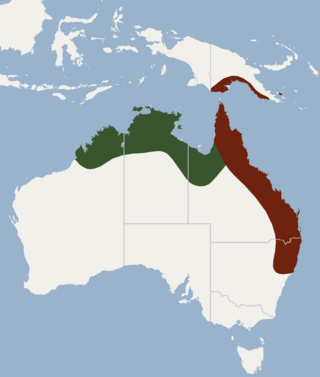
The Inaccessible Island rail is a small bird of the rail family, Rallidae. Endemic to Inaccessible Island in the Tristan Archipelago in the isolated south Atlantic, it is the smallest extant flightless bird in the world. The species was formally described by physician Percy Lowe in 1923 but had first come to the attention of scientists 50 years earlier. The Inaccessible Island rail's taxonomic affinities and origin were a long-standing mystery; in 2018 its closest relative was identified as the South American dot-winged crake, and it was decided that both species are best classified in the genus Laterallus.
Hoplophryne is a genus of microhylid frogs. The genus is endemic to mountain forests of Tanzania. They are also known as three-fingered frogs or African banana frogs.

The Ascension crake is an extinct flightless bird that previously lived on Ascension Island in the South Atlantic Ocean. Like many other flightless birds on isolated islands, it was a rail. It was declared extinct by Groombridge in 1994; BirdLife International confirmed this in 2000 and 2004.

The Himalayan swiftlet is a small swift. It is a common colonial breeder in the Himalayas and Southeast Asia. Some populations are migratory.

The hoary wattled bat is a species of vesper bat found in northern Australia and Papua New Guinea. Two subspecies are currently recognised:
Hoplophryne rogersi, also known as the Tanzania banana frog, Usambara banana frog, Usambara blue-bellied frog, and Roger's three-fingered frog, is a species of frog in the family Microhylidae. It is endemic to north-eastern Tanzania and known from the Usambara, Magrotto, and Nguru Mountains of Tanga Region. The specific name rogersi honours F. W. Rogers, the custodian of the Amani Research Institute at the time of the describers' visit to Usambara.
Parhoplophryne is a monotypic frog genus in the family Microhylidae. The sole species is Parhoplophryne usambarica, sometimes known as the Usambara black-banded frog or Amani forest frog. It is endemic to the East Usambara Mountains in Tanzania. It is only known from one specimen collected in the 1920s and is feared to be extinct.

The Papuan frogmouth is a species of bird in the family Podargidae, found in the Aru Islands, New Guinea, and in Cape York Peninsula, Queensland, Australia.
Tomichia cawstoni is a species of very small freshwater snails which have a gill and an operculum, gastropod molluscs or micromolluscs in the family Tomichiidae.
Tomichia natalensis is a species of very small freshwater snails which have a gill and an operculum, gastropod molluscs or micromolluscs in the family Tomichiidae.

Gomphus is a genus of clubtail dragonflies in the family Gomphidae.
Kinkonychelys is an extinct genus of side-necked turtle which existed in Madagascar during the Late Cretaceous period. It contains the single species Kinkonychelys rogersi, named in honor of its discoverer, Raymond R. Rogers. The genus and species are based on UA 9748, a nearly complete skull, which represents the first turtle skull described from the pre-Holocene era in Madagascar. A number of isolated skull and jaw bones have also been assigned to K. rogersi. These specimens were found in rocks of the Maastrichtian-age Maevarano Formation in the Mahajanga Basin of northwestern Madagascar. Another specimen, FMNH PR 2446, is speculated to represent another species, currently known as Kinkonychelys sp., but consensus on its distinction from K. rogersi remains unclear.
Tomichia tristis is a species of very small freshwater or brackish snail with a gill and an operculum, gastropod mollusc or micromollusc in the family Tomichiidae.
Tomichia is a genus of very small freshwater snails which have a gill and an operculum, gastropod molluscs or micromolluscs in the family Tomichiidae.

The Pacific emerald dove or brown-capped emerald dove is a pigeon which is a widespread resident breeding bird in the tropical and sub-tropical parts of Indonesia to northern and eastern Australia. It was formerly conspecific with the common emerald dove.
The Mulobozi River is a stream in Tanganyika Province of the southeastern Democratic Republic of the Congo.
Tomichia differens is a species of freshwater gastropod in the family Tomichiidae endemic to perennial streams and rivers in Western Cape Province, South Africa. Described by Connolly in 1939, T. differens is found in two sites at De Kelders and Stilbaai, and has amphibious habits and a tolerance of slight salinity and desiccation throughout its habitats. The genus Tomichia is very sensitive to changes in ecosystem conditions, and thus are threatened by pollution and climate change. The Stilbaai site is in danger of becoming uninhabitable due to residential developments and offshore drilling operations, and thus this species has been listed as Endangered by the IUCN.
Platyceps rogersi, Rogers's racer, is a species of snake of the family Colubridae.







